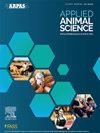Plane of nutrition through 92 days of age in beef × dairy hybrid steers influences subsequent finishing performance, feed efficiency, and carcass characteristics
IF 1.5
Q3 AGRICULTURE, DAIRY & ANIMAL SCIENCE
引用次数: 0
Abstract
Objective
Our objective was to determine the effect of plane of nutrition through 92 d of age on subsequent finishing performance, feed efficiency, and carcass characteristics in beef × dairy crossbred steers.
Materials and Methods
Beef × dairy crossbred steers (n = 109) were acquired from commercial dairies in blocks (n = 2) with 38 and 72 steers per block and transported to the Calf Milk Research Facility at Purina Animal Nutrition in Grey Summit, Missouri, at 7 d of age. Steers were assigned to either a higher nutrient-dense milk replacer (MR) and starter (HI) or moderate nutrient- dense MR and starter (MOD) plane of nutrition through 92 d of age. Steers were weaned at 49 d and sorted into outdoor pens with 3 steers per pen. On d 84, steers were transported to the Willard Sparks Beef Research Center (WSBRC) in Stillwater, Oklahoma. At the WSBRC, steers were sorted by BW within preweaning treatment into 4 to 5 steers/pen and fed for 308 d. Data were analyzed using SAS 9.4 Mixed procedure (SAS Institute Inc., Cary, NC) for all performance and noncategorical carcass measures. For preweaning measurements, individual calf was used as the experimental unit, whereas for finishing phase measurements pen was the experimental unit.
Results and Discussion
Steers fed HI prefinishing exhibited a greater BW through d 168 of the finishing phase and had greater DMI from d 0 to 28 and d 28 to 112, as well as greater percentage USDA Choice. Steers fed MOD had a greater G:F from d 28 to 112 and had greater overall G:F. There were no other differences in carcass characteristics due to preweaning plane of nutrition.
Implications and Applications
Providing calves with lesser nutrient-dense diets during the preweaning period, such as MOD treatment of the current research, did not result in enhanced performance through compensatory gain. Based on this study, a higher preweaning plane of nutrition allows heavier BW through 29 wk of age and improved carcass quality.
92日龄的牛乳杂交阉牛营养水平影响后期肥育性能、饲料效率和胴体特性
目的研究92日龄前不同营养水平对肉牛杂交阉牛后期肥育性能、饲料效率和胴体特性的影响。材料与方法牛乳杂交阉牛(n = 109),分2组(n = 2),每组分别为38头和72头,于7日龄运往密苏里州Grey Summit市Purina动物营养中心小牛奶研究设施。饲喂营养密度较高的代乳粉和发菜(HI)或中等营养密度的代乳粉和发菜(MOD),直至92日龄。49 d断奶,分装到室外猪圈,每个猪圈3头。84日,肉牛被运往俄克拉荷马州斯蒂尔沃特的威拉德·斯帕克斯牛肉研究中心(WSBRC)。在WSBRC,断奶前的阉牛按体重分为4 - 5头/栏,饲喂308 d。数据采用SAS 9.4混合程序(SAS Institute Inc., Cary, NC)进行所有性能和非分类胴体测量分析。断奶前测量以犊牛个体为实验单位,育肥期测量以猪栏为实验单位。结果和讨论饲喂HI预育的阉牛在肥育期第168天表现出更高的体重,在第0 ~ 28天和第28 ~ 112天表现出更高的DMI,以及更高的USDA选择百分比。饲喂MOD的阉牛在第28天至第112天的G:F更高,总体G:F也更高。断奶前营养水平对胴体性状无其他影响。启示和应用在断奶前给犊牛提供营养密度较低的日粮,如本研究中的MOD处理,并不能通过补偿性增重提高生产性能。本研究表明,较高的断奶前营养水平可提高29周龄仔猪的体重,提高胴体品质。
本文章由计算机程序翻译,如有差异,请以英文原文为准。
求助全文
约1分钟内获得全文
求助全文

 求助内容:
求助内容: 应助结果提醒方式:
应助结果提醒方式:


